
About UsThe Numismatic Bibliomania Society is a non-profit organization promoting numismatic literature. For more information please see our web site at coinbooks.org SubscriptionsThose wishing to become new E-Sylum subscribers (or wishing to Unsubscribe) can go to the following web page link MembershipThere is a membership application available on the web site Membership Application To join, print the application and return it with your check to the address printed on the application. Membership is only $15 to addresses in the U.S., $20 for First Class mail, and $25 elsewhere. For those without web access, write to: David M. Sundman, Secretary/TreasurerNumismatic Bibliomania
Society AsylumFor Asylum mailing address changes and other membership questions, contact David at this email address: dsundman@LittletonCoin.com SubmissionsTo submit items for publication in The E-Sylum, just Reply to this message, or write to the Editor at this address: whomren@coinlibrary.com
BUY THE BOOK BEFORE THE COINYou won't regret it! |
- WAYNE'S WORDS: THE E-SYLUM JANUARY 15, 2012
- KOLBE & FANNING 2012 NEW YORK BOOK SALE RESULTS
- NBS WEB SITE BIBLIOGRAPHY UPDATED
- SURVEY: INSTITUTIONAL NUMISMATIC LIBRARIES OF THE WORLD
- ANA MUSEUM LOOTED OF $1 MILLION IN RARE COINS
- MUSEUM OF LONDON PUTTING COIN IMAGES ONLINE
- DICK JOHNSON REMINISCES: TYPE DRAWERS AND PRINTING
- MORE ON LINCOLN'S LAST CHECK
- MORE ON DOG LICENSE TAGS
- NOTES FROM E-SYLUM READERS: JANUARY 15, 2012
- KEN BERGER PUTS IRRADIATED DIMES TO THE TEST
- WAYNE'S NUMISMATIC DIARY: JANUARY 15, 2012
- THE BATHING ABSENT MINDED BEGGAR MEDAL
- MORE ON JEAN CASTAING
- BANK OF THAILAND TO LAUNCH NEW BANKNOTE SERIES
- CONSERVATORS PIECE TOGETHER A ROMAN CAVALRY HELMET
- THINK TANK RECOMMENDS MELTING 'GOLD' COINS
- FEATURED WEB SITE: THE LEADEN TOKENS TELEGRAPH
WAYNE'S WORDS: THE E-SYLUM JANUARY 15, 2012

New subscribers this week include Arthur and Prue Fitts and Sherry Briggs, Jack Hoadley and Todd Salmon, all courtesy of Bob Fritsch, Roger J. Merritt, courtesy of Alan V. Weinberg, and Evan J Brooke. We have 1,494 email subscribers, plus 170 followers on Facebook.
This week we open with results from the New York Kolbe & Fanning book sale and the unveiling of a new section of the NBS online numismatic bibliography.
Other topics this week include the ANA Museum theft, reminiscences from Dick Johnson, and the Leaden Tokens Telegraph.
To learn more about Jean Castaing, the Bathing Absent Minded Beggar Medal and the results of the Great Irradiated Dime test, read on. Have a great week, everyone!
Wayne Homren
(whomren@gmail.com)
Numismatic Bibliomania Society
KOLBE & FANNING 2012 NEW YORK BOOK SALE RESULTS
 Kolbe & Fanning's characterization of their January 7, 2012 New York Book Sale as "Small but Mighty" has turned out to be quite apt. Of the 350 lots in the sale, 305 sold for a total of $514,000, or an average price per lot of nearly $1700 (all prices cited herein include the 15% buyer premium). Prices achieved ran from $144 to $40,250, the latter amount realized by two consecutive lots, the inventory of the Colonel E.H.R. Green coin collection and a set of three volumes of photographs depicting his fabled collections of U.S. gold quarter eagles, half eagles, and eagles.
Kolbe & Fanning's characterization of their January 7, 2012 New York Book Sale as "Small but Mighty" has turned out to be quite apt. Of the 350 lots in the sale, 305 sold for a total of $514,000, or an average price per lot of nearly $1700 (all prices cited herein include the 15% buyer premium). Prices achieved ran from $144 to $40,250, the latter amount realized by two consecutive lots, the inventory of the Colonel E.H.R. Green coin collection and a set of three volumes of photographs depicting his fabled collections of U.S. gold quarter eagles, half eagles, and eagles.
Other sale highlights include:
• Dr. Jacob Hirsh's unique annotated set of 164 proof plates depicting the original Pozzi collection of ancient Greek coins, which sold for $11,500
• Thomas Jefferson's remarkable 1790 Report on the Weights, Measures and Coins of the United States, a foundational document in American numismatics, which realized $16,100
• A remarkable archive of over 100 White proof bank notes from the Russian Civil War, which brought triple estimate or $25,875
• A nice example of the first printed book, Guillaume Budé's landmark 1514 De asse et partibus eius, which was hammered at $13,800
• A spectacular Bureau of Engraving and Printing Vignette Book, in a deluxe binding featuring well over 200 steel-plate printed BEP portraits and vignettes, which sold for $13,800
• An exceptional, complete set of Visconti and Mongez's massive and "glorious" 1808-26 Iconographie grecque et romaine, which realized $11,500
• Over two dozen original plated Chapman brother sales, mostly in excellent condition, generally produced excellent results
• A small selection of rare Russian numismatic works by and large brought prices well in excess of their estimates
• A delightful 1720 manuscript on coin collecting by David Jennings sold for $5,462
• Rare works and manuscripts on American colonial numismatics, several from the library of George C. Perkins, generally produced strong results.
Full color illustrated catalogues are still available and may be obtained by sending $35 to: KOLBE & FANNING NUMISMATIC BOOKSELLERS LLC, 141 W JOHNSTOWN ROAD, GAHANNA OH 43230-2700.
Plans are already being made for Kolbe & Fanning's January 2013 New York Book Sale, to be held at the Waldorf Astoria Hotel in conjunction with the 41st New York International Numismatic Convention. It is not too soon to consider consigning outstanding works to the 2013 New York Book Sale or to other Kolbe & Fanning sales, currently scheduled for June 7th and October 4th, 2012. Contact details are provided at www.numislit.com or interested parties may call (614) 414-0855.
NBS WEB SITE BIBLIOGRAPHY UPDATED
Tom Wetter has been working long and hard adding listings and images to the U.S. section of the NBS web site bibliography Wiki. Several other E-Sylum readers and NBS members have been assisting him by providing information and book images. These include Charlie Davis, David Fanning, Mike Paradis, Dan Hamelberg, Steve Shupe and several others.
This is quickly becoming an awesome resource for collectors of U.S. numismatic literature. We started with the "top 100" as defined by the earlier NBS survey. Then Tom moved on to the "2nd 100" listed on the voting ballot.
Everyone should spend some time poking around thru the bibliography. While far from complete, there is a lot of great information here, and many opportunities for everyone to pitch in.
Here's one sample entry, on Clapp's The United States Cents of the Years 1798-1799:
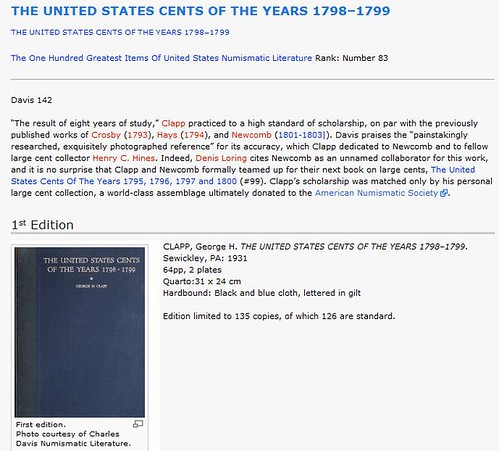
And here's the full table of contents:

To browse the bibliography, see:
MODERN COINAGES: UNITED STATES
(wiki.coinbooks.org/index.php/MODERN_COINAGES:
_UNITED_STATES)
SURVEY: INSTITUTIONAL NUMISMATIC LIBRARIES OF THE WORLD
Thanks very much for publishing information about my study on numismatic libraries in The E-Sylum v.14#52 (December 18, 2011).
The survey instrument only allows one response from each e-mail invitation link or e-mail address. So the link on the e-mail invitation that I sent to you and was included in The E-Sylum was only for one e-mail address. Surveys that were filled out via the link published in The E-Sylum didn't work. To readers who responded and filled out the survey via the link, and others who would like to fill out the survey: please send your e-mail address to me (bbonoussmit@qcc.cuny.edu). I have to send them their own e-mail invitation with customized link.
To read the earlier E-Sylum article, see: SURVEY: INSTITUTIONAL NUMISMATIC LIBRARIES OF THE WORLD (www.coinbooks.org/esylum_v14n52a05.html)
THE BOOK BAZARRE
Exonumia Books Wanted: Singles or Entire LibrariesAlso need: Price Catalogue of U.S. Colonial and Continental Currency, Wissbuch
Rich Hartzog - World Exonumia www.exonumia.com hartzog@exonumia.com
ANA MUSEUM LOOTED OF $1 MILLION IN RARE COINS
Former ANA collections manager Wyatt Yeager entered a guilty plea today in Federal District Court in Wilmington, DE, to the theft of approximately 300 historically significant coins and other numismatic objects, valued at $984,740, from the American Numismatic Association Money Museum, ANA President Tom Hallenbeck has announced.
Yeager, 33, was the museum's collections manager from January through March 2007 and is charged with Theft of Major Artwork, violation of Title 18, United States, Section 668. Yeager faces a maximum statutory penalty of 10 years imprisonment, a $250,000 fine and three years supervised release following any term of imprisonment. Among the stolen items are an Australian 1813 Holey Dollar, a 1795 Half Eagle and an 1836 Gobrecht Dollar.
The theft was discovered by museum officials in October 2007 and was the subject of an extensive FBI investigation after museum staff confirmed the missing items. The museum staff worked with authorities during the investigation and played a critical role in helping to uncover vital evidence in the case. The theft was kept confidential so as not to compromise the ongoing investigation, during which Yeager relocated to Ireland. Yeager sold numerous rare coins stolen from the museum.
"This is a terrible loss for the ANA, the hobby and for coin collectors everywhere," Hallenbeck said. "Prosecution of this crime has been pursued in accordance with the law. The ANA is continuing this investigation and will diligently pursue the recovery of the stolen items."
The ANA retained Robert Wittman, Inc., a security and recovery consulting firm that specializes in recovering stolen art and collectibles, to investigate and recover the stolen coins. Robert K. Wittman, the company's founder and chief investigator, was the founder of the FBI's National Art Crime Team.
A list of stolen items can be found at www.money.org, by scrolling over the "Communications" dropdown menu and selecting "Museum Theft." A link to the U.S. Department of Justice press release and indictment will be available on the site.
As a result of the theft, the ANA has embarked on an upgrade to its security systems and further modified its internal security procedures. In addition, many of the ANA's important coins are being encapsulated by NGC to allow better inventory control through modern bar coding technology, photography and other enhanced security procedures.
"I want to reassure our members - and hobbyists everywhere - that the ANA is committed to improving the security of its collection, which is a true national treasure. As new technologies are developed, we will continually assess our security needs," Hallenbeck said. "Unfortunately, about 90 percent of museum thefts have some insider component."
"Many of the stolen items were desirable and historically significant," Hallenbeck said. "The ANA maintains theft insurance for its numismatic collections, but no amount of insurance can adequately replace these coins - or the loss of trust or sense of helplessness that we all feel following such a theft."
Weren't there standard procedures in place to prevent this? Who was this guy? I'm not as connected with the hobby as one might think, but I know a lot of people and yet I've never heard of him. The Executive Director ought to be fired. Oh wait, he WAS fired (in October 2007)...
In my book, the buck stops there - even if the Big Cheese had no direct involvement, it is still their responsibility to ensure that the proper checks and balances are in place and being correctly followed. In another time and place the shamed executive would commit Hara Kiri. -Editor
To view the stolen item inventory, see:
Items stolen from Money Museum collection
(www.money.org/AM/Template.cfm?Section=Home&TEMPLATE=/CM/
HTMLDisplay.cfm&CONTENTID=16736)
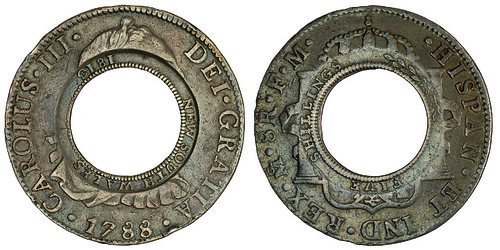
1813 Australian Holey Dollar - location unknown
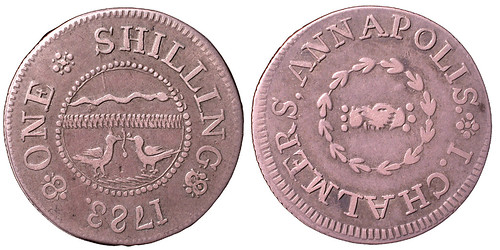
1783 Chalmer's Shilling - location unknown

1656 Mexico Maravillas silver bar - location unknown
Guilty Plea In $1 Million Theft Of Historical Coins
(www.kktv.com/news/headlines/Guilty_Plea_In_
_Million_Theft_Of_Historical_Coins_137209618.html?ref=618)
MUSEUM OF LONDON PUTTING COIN IMAGES ONLINE
The Museum of London is currently working on an ambitious funded project to deliver over 90,000 of its objects online over the next two years, showcasing its diverse collection and opening it up to a worldwide audience. As part of Collections Online, the museum's 4000 strong Roman numismatic collection is currently being digitized and will be made available to the public in August 2012.
The collection consists of finds from all over the city and beyond, comprising hoards and single finds, as well as a significant contribution from the collection of the 19th century Londoner, antiquarian and collector, Thomas Layton. The collection boasts some fine examples of gold, silver and bronze coins, spanning no-less than seven centuries, from a second century BC silver denarii of the Roman Republic, to a gold solidus, issued by the sixth century Byzantine emperor, Justinian I.
It is hoped that bringing the Museum of London's Roman numismatic collection online will not only help the museum engage with a wider public audience, but also offer a considerable contribution to the understanding of Roman numismatics in London, and provide increased opportunity for further numismatic enquiry, study and fresh analysis.
In addition, the Museum's collection of 17th century trade tokens are also being digitized to be put online. This comprises nearly 4000 tokens, issued within the City of London, Middlesex and Southwark, as well as a small portion from further afield. An initial batch of 1800 tokens will be available online from December 2011, with more being added in the following year.
To read the complete article, see: Roman coin project at the Museum of London (www.coinsweekly.com/en/News/4?&id=958)
To view the online collections of the Museum of London, see: Collections online (www.museumoflondon.org.uk/Collections-Research/Collections-online/)
THE BOOK BAZARRE
DICK JOHNSON REMINISCES: TYPE DRAWERS AND PRINTING
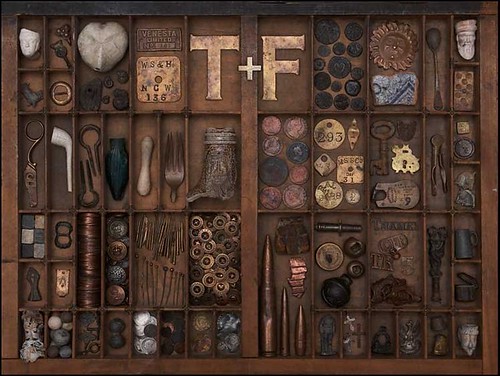
The compartmented tray illustrated in the Thames and Field web site article in last week's E-Sylum looked familiar. It is a type drawer to hold a font of type. It's a California style drawer but it is upside down.
As I recall the lower case letter "e" would be were the "F" is located in the illustration. Larger compartments would contain pieces of type (letters) that are used most often and closer to the front. Capital letters and punctuation marks -- the least used -- were in the smallest boxes at back of the tray (shown at the bottom of the illustration).
It has been 54 years since I touched such a type tray. As a 15-year-old high school student I purchased a 10 x 15-inch Chandler & Price printing press and taught myself how to print. I bought a cabinet that must have held 100s of drawers as I remember I had 120 fonts of type in a variety of sizes and typefaces. I printed stationery, business cards, play programs for school and even membership cards for the Heart of America Numismatic Association (and other organizations).
Two years later I bought the next size larger Chadler & Price press. And more type. Anyone who has set type by hand, locked it in a frame, put the frame in a press, and printed a first impression will know the thrill of seeing your handwork in print. It set me up for a lifetime as a lover of the printed word and related fields of writing and book collecting.
But as print shop entrepreneur my venture was short lived. At 18 I was about to be drafted into the Korean War (So I enlisted for four years in the Air Force.) Instead of leaving the infant print shop unattended I sold it intact to a fellow coin collector, James G. McNees. His profession was a photoengraver (so he could make all the "cuts" or "halftones" or illustrations he wanted). Also he had four sons he wanted to teach printing.
Jim ultimately started a coin publication -- Coin Collectors Digest -- printed on my old presses. We mentioned that publication previously in The E-Sylum (vol 12, No 1, Art 8, January 4, 2009)
But type cases had an ignoble death. Type for any kind of printing (letterpress or offset) could be set by computer at far less expense. Fast forward to 1968. I worked in Midtown Manhattan (at Medallic Art Co on East 45th Street). This was in the center of all the service industries for the advertising agencies on Madison Avenue. These included photographers, art agencies, messenger services and typographers which set type for the ad agencies.
I remember one month walking past a multi-story building on 45th Street that contained dozens of type setting houses. In the street was the largest trash containers I had ever seen. They were trashing those type trays, tens of thousands of them. They could sell the type as scrap for the lead and antimony they contained, but those trays had no value. Out they went.
I've seen other art montages using old type drawers. But no one could use tens of thousands.
To read the earlier E-Sylum article, see: FEATURED WEB SITE: THAMES AND FIELD METAL DETECTING SOCIETY (www.coinbooks.org/esylum_v15n02a27.html)
MORE ON LINCOLN'S LAST CHECK

A personal check that Abraham Lincoln wrote the day before he was assassinated is among those that were rediscovered by an Ohio bank.
The Plain Dealer in Cleveland reports that 70 checks were found in a vault at Huntington Bank's Columbus headquarters, including checks signed by George Washington, Mark Twain, Charles Dickens and Thomas Edison. Some are being displayed at branches throughout the state.
The Lincoln check had been made out to 'self' for $800.
The checks had been stored in a vault since at least 1983, when Huntington took over another bank, the Associated Press reports.
An employee had begun looking through old boxes last year, which led to the discovery of the checks.
A Union Commerce president had developed the check collection, Huntington spokeswoman Maureen Brown told The Associated Press.
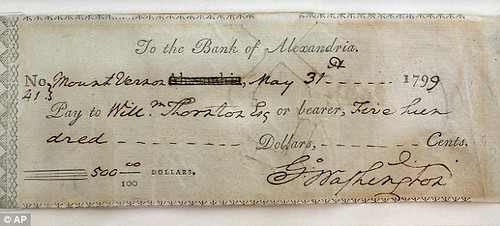
To read the complete article, see:
Last check for $800 Abraham Lincoln wrote the day before he was assassinated is discovered after 150 years (and it's now worth $25,000)
(www.dailymail.co.uk/news/article-2086848/Check-President
-Abraham-Lincoln-wrote-day-killed-discovered-bank-vault.html)
MORE ON DOG LICENSE TAGS
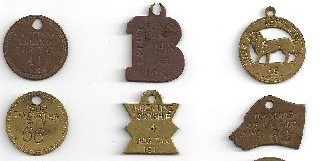
Regarding the discussion on dog license tags:
The master work, "U.S. Dog License Tags and Related Exonumia," is by William J. Bone, D.V.M., a very personable and knowledgeable guy. He published a limited number of copies in 2005.
This collecting field is evidently popular. A check on eBay showed hundreds of offerings, with many tags dating back decades. Information available on Web sites includes the datum that dog licensing goes back at least to the 1400s in Europe, though metal tags came along later. Some of these tags are colorful or unusual in shape. Like coins, they usually carry dates. They also bear local place names.
An interesting question is whether rabies vaccination tags, equally interesting, also qualify as exonumia. In many or most cases, these probably represent fulfillment of a legal obligation and payment of a fee, at least to a veterinarian. The number of place names multiplies by the number of local veterinarians.
To read the earlier E-Sylum article, see: ARE DOG LICENSE TAGS EXONUMIA? (www.coinbooks.org/esylum_v15n02a09.html)

NOTES FROM E-SYLUM READERS: JANUARY 15, 2012
An Eye for an Eye, a Piece for a Piece
Last week's item about the Roman brothel token was one of my favorites. According to the quoted article,
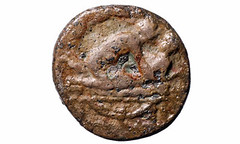 On the reverse of the token is the numeral XIIII, which experts say could indicate the holder handed over 14 small Roman coins called asses to buy it.
On the reverse of the token is the numeral XIIII, which experts say could indicate the holder handed over 14 small Roman coins called asses to buy it.
Bill Eckberg writes:
So, 14 whole asses for one piece of ass? Does that make sense?
To read the earlier E-Sylum article, see: ROMAN BROTHEL TOKEN UNCOVERED IN LONDON (www.coinbooks.org/esylum_v15n02a17.html)
The Beistle Company Archives
David Lange writes:
I was glad to see Bill Bugert chime in about the Raymond Christmas Tree and the Beistle Company. Bill has been extremely helpful and generous in both loaning me images he shot at the Beistle Company in Pennsylvania and providing me with an introduction to company President Tricia Lacy. I plan to visit Shippensburg myself after winter recedes and examine the Beistle Company archive of letters and coin holders.
It's simply amazing that the company remains family owned after all these years and that it has retained examples of products that went out of production decades ago. I'm having a lot harder time learning about coin album publishers of the 1950s and '60s, because they seem to have left behind almost nothing but the used albums!
To read the earlier E-Sylum article, see: MORE ON THE RAYMOND-BEISTLE CHRISTMAS TREE COIN HOLDER (www.coinbooks.org/esylum_v15n01a13.html)
The Liberty Dollar and the Price of Silver
In an earlier E-Sylum article, Bob Leonard wrote:
"But even von NotHaus is not above market forces: when I bought my Liberty Dollar, silver was about $6 an ounce (the quote from their website gives only $5.10), and the face value and selling price (one troy ounce, proof) was $10; now that silver has broken $8, I see that the face value of a 2005 Liberty Dollar has doubled to $20. For an "inflation-proof" currency this is not how it's supposed to work!"
Web site visitor Paul Brett writes:
This is not sound economics - the real value of the metal is going up in this case of Liberty Dollars, meaning you can buy more with it. Extra paper money is being created from nothing meaning that you can buy less with it. It is only purchasing power that counts.
To read the earlier E-Sylum article, see: IN DEFENSE OF THE LIBERTY DOLLAR (coinbooks.org/esylum_v08n52a20.html)
COIN Company
Dick Johnson writes:
I got a stock advisory Saturday for COIN (Pink symbol for Converted Organics INc). Its a PENNY stock. They manufacture fertilizer!
Not from coins I hope.
We don't make this stuff up. Here's my proof: Converted Organics Inc. (COIN)
More on the Sydney Emden Medal
Jim Downey writes:
A couple of issues of The E-Sylum ago there was a discussion of the commemorative badges made in Australia for the sinking of the SMS Emden by the HMAS Sydney in WWI. The badges were made from Mexican 8 reales pieces captured from the Emden. Attached is the other side of the coin, so to speak.
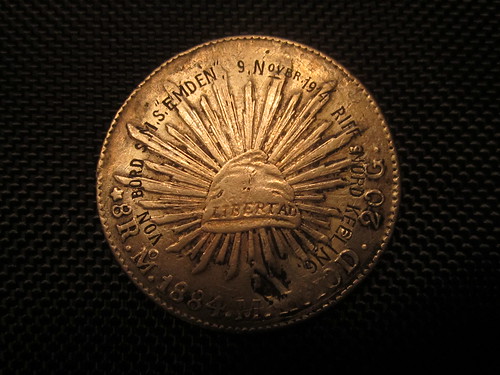
KEN BERGER PUTS IRRADIATED DIMES TO THE TEST
In an earlier article Ken Berger wrote:
Making dimes radioactive was discontinued only when silver coins disappeared from circulation in the mid-1960s. When exposed, the silver in the dimes changed from Ag-109, which absorbed neutrons very easily, to AG-110, which is radioactive. The dimes, for about four minutes, were capable of emitting low-energy beta radiation. After 10 half-life periods, less than a tenth of one percent of the original activity remained and could be detected only by highly sophisticated equipment. . . . the exposed silver transformed itself into stable Cadmium-110."
Based upon the foregoing, I find it hard to believe that "If you have a Geiger counter you can confirm this! Indeed, this was done at an early Fest" as was stated in an earlier Esylum." For this to occur, that dime had to be hit with a LOT more radiation than was being used. I would guess the Geiger counter used at the Fest was picking normal background radiation and not radiation from the dime. Indeed, if you turn a Geiger counter on (as I have done in my geology classes), every now and then it will click. That is from normal background radiation.
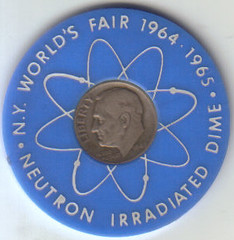 Here's scan of my irradiated dime from the NY World's Fair. It is a 1948 Roosevelt dime. I have never removed the dime, so it is the one that I had originally had irradiated.
Here's scan of my irradiated dime from the NY World's Fair. It is a 1948 Roosevelt dime. I have never removed the dime, so it is the one that I had originally had irradiated.
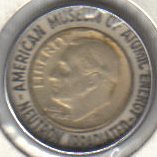 Here is a scan of my 1951 Roosevelt neutron irradiated dime by the American Museum of Atomic Energy. The reverse is blank. I purchased it from a coin dealer in February 1998 for $5.00.
Here is a scan of my 1951 Roosevelt neutron irradiated dime by the American Museum of Atomic Energy. The reverse is blank. I purchased it from a coin dealer in February 1998 for $5.00.
Curious to confirm his suspicion, Ken put his dimes to the test. He writes:
We tested my two dimes (previously pictured in The E-Sylum) with a Geiger Counter at my college. As predicted, they are not radioactive. Every now and then the Geiger Counter would click. This was due to background radiation. We confirmed this by moving the dimes away from the Geiger Counter and every now & then it would still click.
So anybody who says that their dimes are still radioactive are misinformed or are not familiar with background radiation. In fact, if the dimes were still radioactive then when they were first irradiated the radiation would have been at highly unsafe levels.
To read the earlier E-Sylum article, see: MORE ON IRRADIATED DIMES (www.coinbooks.org/esylum_v14n52a10.html)
WAYNE'S NUMISMATIC DIARY: JANUARY 15, 2012
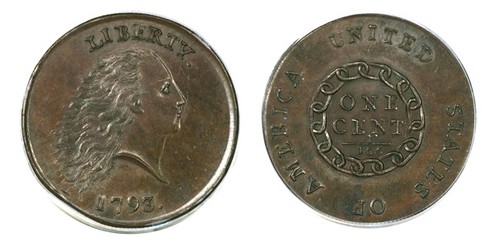
Last week I saw several accounts in the mainstream press about the 1793 Chain Cent which sold for $1.38 million. I even heard the story on the radio. I didn't put anything in The E-Sylum because the articles didn't really provide anything new or interesting in terms of numismatic research. But the topic came up again this week when, of all things, I was helping my son Christopher with his homework. He'd been asked to choose and discuss five articles from the news, and one he'd chosen was about the 1793 cent.
Knowing the auction included a consignment from copper specialist Denis Loring, I blurted out, "I think I know the guy who sold that". We talked a bit about auctions and I told him how I'd sold a lot of items from my own collection in auctions in 2006.
He asked how much my most expensive coin sold for. It wasn't a coin actually - it was a piece of Confederate paper money. But I certainly didn't have anything that hit $1 million, and neither did Denis, at least not in THIS sale. I emailed him about the coin and learned that while he had several 1793 cents in the sale, the $1.38 million one wasn't his. So much for my story. But it was nice to talk coins for a while. I told Chris about the Eliasberg collection, which was mentioned in the article.
To read one of the articles, see:
1793 penny fetches $1.38M at Fla. auction; copper coin from 1st year that US made own coins
(www.washingtonpost.com/national/1793-penny-fetches-1m
-at-fla-auction-copper-coin-was-from-1st-year-that-us-made
-own-coins/2012/01/07/gIQAeowshP_story.html)
By the way, there was a great article on Denis' coins in Coin Week in December:
Coin Rarities & Related Topics: The 1793 Large Cents of Denis Loring
(www.coinweek.com/news/featured-news/coin-rarities
-related-topics-the-1793-large-cents-of-denis-loring/)
Another item that caught my eye this week was about a numismatically-named racehorse:
Although the word "tetradrachm" doesn't exactly roll off the tongue, the name for a son of Badge of Silver is actually quite apropos, because the tetradrachm was an ancient Greek silver coin that was in wide circulation from 510 to 38 B.C. and its use as a currency spread with the armies of Alexander the Great.
To read the complete article, see: Tetradrachm minted as Louisiana Derby hopeful (www.brisnet.com/cgi-bin/editorial/news/article.cgi?id=26018)
On Tuesday night I went to the Wildfire restaurant at the Galleria in Tyson's Corner for the month dinner of my Northern Virginia Numismatic social club Nummis Nova. For a change I was the first one there, but was quickly joined by Wayne Herndon, Joe Levine, Gene Brandenburg, Eric Schena, Mike Packard, Tom Kays, Roger Burdette, Julian Leidman and Dave Schenkman.
A number of interesting numismatic items were passed around the table, including a number of British medals and a double thaler. Tom Kays had a display of new purchases, and I showed my latest addition, a medal from the Belgian Carnegie Hero Fund. Gene Brandenburg passed around a neat white medal in a small red box; Tom Kays has a write-up about this piece later in this issue.
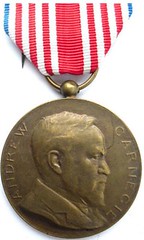
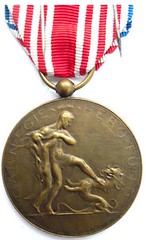
As usual, the drinks and conversation flowed freely. Wayne Herndon told us about his experiences at F.U.N. (it was a great show). Tom Kays passed around an electronic copy of an article he's writing. Eric Schena passed around a manuscript too - this one for a long article on Virginia Ingle System Scrip that he planned to offer to the TAMS Journal.
Thursday afternoon I got an email from Eric's wife Heather - he had come down with a nasty case of food poisoning and was in the hospital. At the request of his doctors I contacted everyone who'd been at the dinner, but none has gotten sick. Gene said "I did have a weird dream about mint marks but that could have been the wine."
I passed along updates on his condition to members throughout the weekend. Eric's improving and feeling better, but as of tonight was still hospitalized. We all miss him and wish him a speedy and full recovery.
At the dinner I picked up a book from Tom Kays - the Quarterman compilation of Numismatist articles on The Coinages of Latin America and the Caribbean. I looked thru it over the weekend and was intrigued by two articles in particular. Both were related to the Bahamas. The first, by Alvin Kress, was about the Bahama Penny of 1806-1807. As for the second one, let's see how much our readers know.
QUICK QUIZ: What were the Cat Cay tokens? Who made them and what was pictured on them? When was the last year they were used? Extra credit goes to anyone who can say they've actually been to the place where they were issued.
Earlier in the week I looked at a Washington Success token on eBay. The seller, Lloyd Wagner, had contacted me asking if I could identify the variety. I couldn't, and with the auction deadline of Saturday the timing wouldn't work to put a question in The E-Sylum. I told him I'd consider bidding on it and exchanged some email privately with Ray Williams.
Ray noted that although the lot description says these are "Presumed to have been struck around Washington's second inauguration in 1793", the "Success Tokens are currently believed to be a product made in the mid-1800s".
In the end I didn't bid and wouldn't have gotten it anyway - it was out of my range. Lloyd reported that "after some fierce bidding, the Washington Success token sold for $1036.58!" What's up with that? Is it a rare variety? Neither of us thought it would bring anywhere near that.

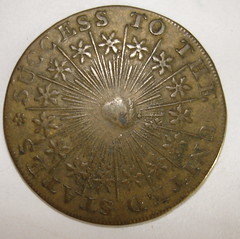
To view the complete lot description, see Rare 1793 George Washington SUCCESS TO THE UNITED STATES Token (http://www.ebay.com/itm/220927904998)
THE BATHING ABSENT MINDED BEGGAR MEDAL
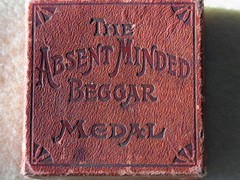 At dinner Gene showed a curious white medal in a small red box he had for many years. Not certain where it was first acquired, the box top reads "The Absent Minded Beggar Medal." Inside a 51mm, white medal of Birmingham describes bathing places with a wheel of cities and miles distant from London.
At dinner Gene showed a curious white medal in a small red box he had for many years. Not certain where it was first acquired, the box top reads "The Absent Minded Beggar Medal." Inside a 51mm, white medal of Birmingham describes bathing places with a wheel of cities and miles distant from London.
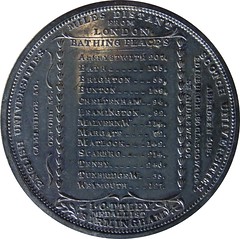
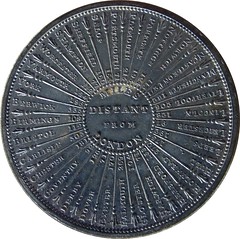
At first we can only guess this would be something of an insult to receive. Imagine being told by London city folk to take a bath and just how far away from London to go to do it. What Londoner would give such an uncouth message and to whom? How often did they insist, "Get outta town, you dirty beggar and take a bath" - and then give the miscreant a nice cased token for the tramp as a reminder of just how far to go before stopping some healthy distance from London.
At dinner we could only guess who would deliver this admonition so often to think of engraving it on a token? In later research, the first clue came from the box top. The "Absent Minded Beggar" is a snippet of poem written by Rudyard Kipling in 1899 to honor wayfaring English lads on their way to South Africa to fight the Boers. Humble English lads in uniform apparently didn't ask much for themselves as they passed among ungrateful and selfish countrymen. Gilbert and Sullivan put the poem to music, a patriotic rallying call to "give, give, give."
In 1900, a national commemorative "Absent Minded Beggar Medal" was issued to honor the magnificent response of Britain's sons to the empire's call to arms in the Transvaal War. This medal was advertised in the Daily Mail to aid widows and orphans of soldiers. The red box was for this medal, but the medal in the box was not the one it ought to be.
Looking further, from "The Sanitarian, a Monthly Magazine Devoted to the Preservation of Health, Mental and Physical Culture," August 1894, Volume 4 of a continuing series entitled "The Medals, Jetons and Tokens Illustrative of Sanitation" by Dr. H. R. Storer of Newport, Rhode Island reports a fine thematic collection of medical-oriented tokens addressing water supplies, mineral springs, bathing, drainage, sewerage, diet and similar topics.
Storer writes: "I am at last enabled to give the description of a medal which I previously merely knew the existence. Obverse: The Principal Bathing Places of England, with miles distant from London. Exergue: J. Ottley, Medalist Birmingham. To right: Scotch Universities; To left: English. Reverse within circle: Miles Distant from London. Between edge and this circle, the names of the principal towns of England, with figure to correspond. Spink & Son Num. Circular, Sept, 1893 P.365, No 4."
In the 19th century, medical cures from "marvelous water," the best in the world, for every known ailment were broadcast in medical journals with tours and testimonials as to the curative affects to be obtained in every spring and brook. Medalist John Ottley was elder of a family of Birmingham medalists including Thomas Ottley operating from about 1818 to 1900. Their medals were known for unbelievable detail.
Sold at auction, I found a cased set inscribed for J. C. Haworth of the Conservative Club of Blackburn England (started in 1864 and by 1881 Hayworth was its president) that held two, 51mm medals in white metal. One was this Bathing Medal and its mate, a detailed "Map of the World" showing the "Sandwich Islands" in lieu of Hawaii. The date of manufacture of both is circa 1850. So it was an ironic pairing of mismatched beggar's case with bathing medal that stumped us for a while. Go figure.
MORE ON JEAN CASTAING
Pete Smith writes:
I first became aware of the Castaing machine when I attended the 1984 Coinage of the Americas Conference at the ANS. George Ewing submitted his paper on "Origins of Edge Lettering on Early American Copper Coinage," This includes material that may expand your knowledge of the subject.
Dick Johnson writes:
French Engineer Jean Castaing ranks in the top twenty most important people who developed minting technology. I ranked these for my Encyclopedia of Coin and Medal Technology. Castaing came in at number 19. His invention of the edge-treating or edge-marking machine was pivotal in the development of coining in the late 17th century.
But it may not have been his original idea. There is some validity that it may have been developed earlier by Pierre Blondeau (ca1620-1664) a Frenchman working in the London Mint. Blondeau was highly secretive and did not want anyone to know of his development (perhaps that is why he is not given credit for this invention).
However, the story is that the French Ambassador gained the information about the device from the Royal Mint in London and passed it on to Castaing at the Paris Mint. There Castaing build a working model in 1685 and this was publicized. (It would be nice to know the first coin to be so edge lettered or treated with Castaing's invention -- if a London Mint product had such treatment.)
We don't know details of Castaing's life. I would be delighted if some researcher could uncover the dates of his birth and death if nothing else.
In addition to the references given last week, Castaing is also listed in Forrer, volume 1, page 359.
Ed Hohertz writes:
Five additional sources of information on Jean Castaing can be found in ANS search and World Catalog. I hope this helps out a little.
To read the earlier E-Sylum article, see: QUERY: INFORMATION ON JEAN CASTAING SOUGHT (www.coinbooks.org/esylum_v15n02a12.html)
THE BOOK BAZARRE
BANK OF THAILAND TO LAUNCH NEW BANKNOTE SERIES
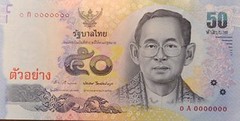 The Bank of Thailand (BoT) will issue a new series of banknotes, its 16th series, next week after the current series has circulated in the market for more than 14 years, according to BoT Governor Prasarn Trairatvorakul.
The Bank of Thailand (BoT) will issue a new series of banknotes, its 16th series, next week after the current series has circulated in the market for more than 14 years, according to BoT Governor Prasarn Trairatvorakul.
Mr Prasarn said that the new notes comprise five denominations -- Bt20, Bt50, Bt100, Bt500 and Bt1,000. Their size and colour remain unchanged from the present notes.
First launches will be the Bt50 banknote on January 18, the date commemorating the glorious victory of King Naresuan the Great in traditional royal combat on elephant back in 1593, he said.
The central bank has applied newest technology as a security feature for the Bt50 note to prevent counterfeiting which included the watermark which HM the King's portrait will be shown on the right side and a watermark of Thai numeral 50 is especially transparent.
The current Bt50 banknote and those previously issued would also be legal tender by law, he said. (MCOT online news)
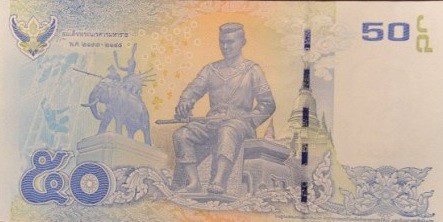
To read the complete article, see: Bank of Thailand launching new banknote series next week (www.mcot.net/cfcustom/cache_page/317334.html)
CONSERVATORS PIECE TOGETHER A ROMAN CAVALRY HELMET
David Sundman writes:
This is pretty neat. It's not entirely clear to me from reading this whether the coins were originally in the helmet, or whether the helmet was just another part of the find.
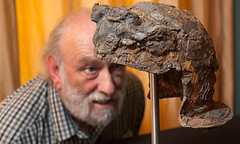 A silver-gilt Roman cavalry helmet of international importance has been pieced together at the British Museum, from thousands of fragments of corroded metal lifted in a block of mud from a Leicestershire hillside more than 10 years ago.
A silver-gilt Roman cavalry helmet of international importance has been pieced together at the British Museum, from thousands of fragments of corroded metal lifted in a block of mud from a Leicestershire hillside more than 10 years ago.
The work has occupied a team of conservators for years. The arguments about the mystery of such a high status object - possibly buried in the year of the Roman invasion of Britain, together with a mass of Roman and British coins and guarded by three dead dogs - will last much longer.
Even after thousands of hours of work by conservator Marilyn Hockey and her team, the metal is too badly corroded to recover its original glitter. Although it is a unique find in Britain because most of the thin silver-gilt plating survives, and an exceptionally early example from anywhere in the Roman empire, the Hallaton helmet will never be as seductively beautiful as the Crosby Garrett helmet, excavated in Cumbria and controversially auctioned for £2m at Christies in 2010.
The original owner would have shone in the sun like a god when he appeared on horseback wearing the helmet, of elaborately decorated silver over an iron core. Such objects were costly pieces of swagger never intended for practical use, but often given as rewards for exceptional service - in this case a gift of imperial quality.
It was when Ken Wallace, a retired teacher and member of a local field archaeology group, saw a lifesize silver human ear in the mud in 2001, that he knew an already astonishing hoard had yielded up something extraordinary.
He and other amateur archaeologists from the Hallaton Fieldwork Group found some pieces of Roman pottery on a low hill outside their village in 2000. Wallace returned with his metal detector, and started turning up coins - at which point he heroically stopped digging and called in the experts, including archaeologists from the British Museum and Leicester university.
The site is now believed a major British hilltop ritual enclosure, protected by an east-facing ditch.
The unearthed treasure was, in Wallace's words, "jaw-dropping". It included one of the largest hoards of Iron Age coins, more than 5,000 pieces of Roman and British gold and silver - including the oldest Roman coin ever found in Britain, a heavily worn pre-imperial denarius minted in 250 BC.
To read the complete article, see:
Unique Roman cavalry helmet pieced together 10 years after discovery
(www.guardian.co.uk/uk/2012/jan/10/unique
-roman-helmet-pieced-together)
THINK TANK RECOMMENDS MELTING 'GOLD' COINS
Phillip Smith says he considers himself to be a "think tank". While many people take information at face value, he spends time thinking about the 'why' behind it. And that's led him to reach out to President Obama about reducing the national debt.
Smith believes if the government would take all of the gold coins out of circulation and melt them into bars, the U.S. would be able to pay off the national debt. He says the gold coins are not doing anybody good just sitting around so the government should take action.
"One troy ounce--depending on who you sell it to--goes for $600 to $800. And our government is sitting on billions of those gold coins," he said. "Why don't you have our government melt it down?"
Smith says he just hopes the American people don't flood the market before the government can melt the coins. That would mean less money per ounce of gold for each coin, and he says he believes it is more important for the government to reduce our deficit than for people to get a little extra cash off old jewelry.
Smith says he sent a letter to President Obama asking him to look into this, but he is still waiting to hear back.
To read the complete article, see: Melting Gold Coins To Reduce National Debt (www.kjct8.com/news/30172361/detail.html)
FEATURED WEB SITE: THE LEADEN TOKENS TELEGRAPH
This week's Featured Web Site is the home of the 'Leaden Tokens Telegraph', edited by David Powell.A free newsletter to all who share our interest in these fascinating and often enigmatic pieces.

www.mernick.org.uk/leadtokens/
